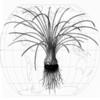| Publication Type: | Journal Article |
| Year of Publication: | 2006 |
| Authors: | C. C. MacLuf, Morbelli, M. A., Giudice, G. E. |
| Journal: | Botanical Review |
| Volume: | 72 |
| Issue: | 2 |
| Pagination: | 135 - 152 |
| Date Published: | 2006/// |
| Abstract: | The microspores of Isoetes escondidensis, I. gardneriana, I. herzogii, I. pedersenii, and I. savatieri were analyzed with transmission and scanning electron microscopy. The selected species were found to be representative of the diversity found in 24 taxa previously studied that grow in southern South America. The sporoderm is similar in the five types and is composed, from the outside to the inside, of perispore, para-exospore, exospore, and endospore. In I. escondidensis, I. gardneriana, I. herzogii, and I. savatieri, the perispore is lacunose, whereas in I. pedersenii, it is camerate. The para-exospore is formed of large superimposed and fused bars, which are more numerous and thicker in immature spores. The exospore shows uniform characteristics and a strongly contrasted cover. It has pluristratified zones on both sides of the aperture. The presence of radial rodlets between the para-exospore and exospore and in the supra-apertural chamber is described here for the first time. The endospore has a fibrillate or reticulate structure, or both structures may be present. A boundary within the fibrillate endospore is evident, which might be related to stages of deposition. The surface characteristics are formed by either the middle and outer strata of the perispore or elements on the outer surface, as in I. escondidensis. The characteristics of the microspore surface and of the perispore structure provide characteristics useful for systematic purposes at the infrageneric level. © 2006 The New York Botanical Garden. |
| URL: | http://www.scopus.com/inward/record.url?eid=2-s2.0-33746021654&partnerID=40&md5=26eb94864942b89e789f6d0eac8944dc |
